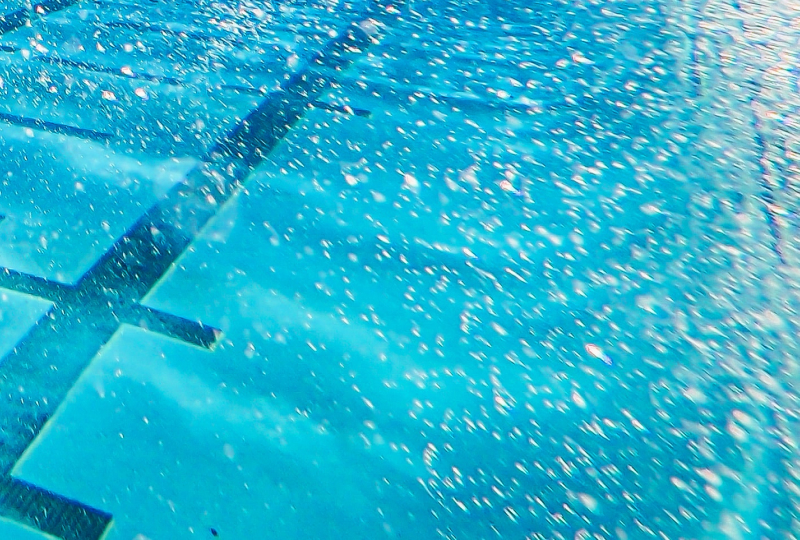
Bubbles Coming Out of Pool Jets
Seeing bubbles in your pool is a common problem, especially at the start of the pool season. But unless you use an ozone generator installed in your pool plumbing system or have just turned on the pool pump, there should not be a large number of bubbles exiting your pool jets.
Causes Of Air Bubbles In Pool Jets
There are several places you’ll need to check to determine the source of air in your pool pump:
1. Water Level
When the water level is too low, the skimmer will pull in air instead of water. This will result in air bubbles exiting from the return jets.
2. Pump Problem
A cracked pump lid, damaged pump lid o-ring, or incorrectly positioned pump basket can cause air to enter your pool lines and create bubbling pool jets. When that’s the case, a pump will start to suck in air instead of water from your swimming pool.
3. Compromised Union(s)
Unions are helpful when pool equipment needs replacing or repairing but can create air bubbles in pool jets if they’re loose.

How To Fix Air Bubbles In Pool Jets
If you have bubbles coming out of pool jets, fix the issue as soon as possible. Otherwise, you could cause severe damage to your pool equipment, such as burning out the pump motor. Poor filtration and an algae infestation can also occur when you prolong fixing the issue.
To repair the problem, complete the following:
1. Inspect Water Level
Your water should be at least halfway up the skimmer’s opening. If your water level is less than that, add fresh water to fix the air bubble problem. Once it reaches the proper level, allow the system some time to purge any air that’s still trapped.
2. Check the Skimmer
Ensure that your skimmer basket is seated correctly and isn’t damaged or clogged. The weir (located at the front of the skimmer) can sometimes get jammed, resulting in poor water suction. Ensure it can move easily.
3. Inspect Your Pump
Check for bubbling in the strainer pot below the lid to determine whether your air leak is from the suction or discharge side of your pool’s filtration system. If bubbles are present, the air is entering the lines on the suction side of the pump. It is improbable for air to enter the pool system on the discharge side.
Your strainer pot lid must be tightly closed; otherwise, air can enter through the lid and get into the pump. Its o-ring should also be positioned appropriately with no damage or dirt-creating obstructions. To verify, power the pump off, remove the lid, then complete an inspection of the o-ring. The o-ring should be replaced if it’s not flexible, smooth, or in otherwise good condition.
Also, verify that the pump lid, pump basket, and drain plugs aren’t damaged. A damaged pump lid or basket needs replacing. Pipe thread sealant tape can be applied to drain plug threads for tighter seals.
4. Check the Union(s)
A common cause of pool jets bubbling is a loose pump/valve union.
Inground pools likely contain some unions in the plumbing. Unions are threaded connection points that allow pool owners to conveniently replace pool equipment without cutting any pipes. If a union is loose, air can enter the pool lines, resulting in air bubbles in pool jets.
To check the unions, turn the pool pump off and remove the nut covering the union. Inspect each o-ring contained inside a union and replace it if necessary. Also ensure that each o-ring is seated correctly in its groove, preventing air from coming in. When tightening the union back up, check that the flange is flush with the back of the nut and that debris is not interfering with a tight closure.
5. Suction-Side Leaks From Main Drain or Skimmer Line
Air coming out of pool jets can also be caused by suction-side leaks in your plumbing from your main drain or skimmer line.
If you have an inground pool, fixing suction side leaks typically involves having a pool professional trace the cause to an underground pipe location. Since above-ground pools lack buried pipework, this won’t be as complicated to repair.
6. Solar Panel Leak
If you’re using solar panels to add heat to your pool, they may allow air to enter if you have a faulty vacuum breaker.
Located at the highest point of the solar pool heating system, a vacuum breaker permits air to enter the system and drain out when the pump’s shut off. If it’s damaged, air gets sucked in continuously and can result in bubbles from pool jets.
To replace a faulty vacuum breaker, place the new part where the upper-end cap is located, then tighten using a hose clamp. Ensure the feedline runs downhill to a 3-way valve, which is in either an open or a non-positive seal position.

